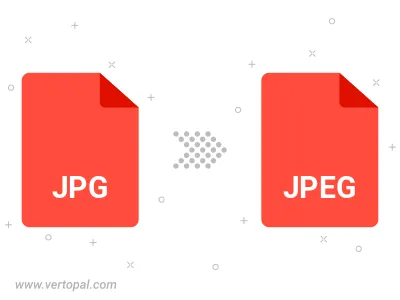Convert JPG to JPEG
Convert JPG images to JPEG format, edit and optimize images online and free.

The JPEG (Joint Photographic Experts Group) file extension, abbreviated as JPG, is a widely used format for digital images. Originating from a standard established by the Joint Photographic Experts Group in 1992, it became the go-to choice for compressing photographic images due to its balance of compression and image quality. JPG files are particularly effective for web use, digital photography, and archival storage where color fidelity and small file size are paramount. This format's lossy compression reduces file size by discarding non-essential data, making it efficient for online image sharing and storage.
JPEG, short for Joint Photographic Experts Group, is a widely-used image file format for compressing digital photographs. Established in 1992 by the Joint Photographic Experts Group, it revolutionized digital imagery by providing efficient, lossy compression that maintains significant image quality. Primarily used in digital cameras, web graphics, and image sharing, JPEG files support full-color imaging with 24-bit depth, enabling detailed and high-quality photographs in relatively small file sizes.
Choose your JPG image for uploading to our JPG converter.
Before clicking the Convert button, use any available JPG to JPEG tools.
Wait a few moments for the converter to complete its job, then download your JPEG file.

Rotate JPG to right (90° clockwise), to left (90° counter-clockwise), 180°, and convert it to JPEG.
Flip JPG vertically and/or horizontally (flop), and convert it to JPEG.
Convert JPG to JPEG and change the JPEG quality by adjusting the JPEG compression level.
Convert JPG to progressive JPEG.
To change JPG format to JPEG, upload your JPG file to proceed to the preview page. Use any available tools if you want to edit and manipulate your JPG file. Click on the convert button and wait for the convert to complete. Download the converted JPEG file afterward.
JPG and JPEG are identical formats based on the Joint Photographic Experts Group standard. The difference lies in the file extension, where older Windows versions used three-letter extensions (JPG), while modern systems accept both JPG and JPEG interchangeably.
No, converting between JPG and JPEG does not alter image quality, as both formats use the same compression algorithm. The conversion is merely a renaming process without any impact on the image data.
You can rename the file extension manually or use image editing software and online converters, such as Vertopal and its CLI tool, that support batch processing for quick and automated conversion.
Most modern applications, operating systems, and web platforms support both JPG and JPEG formats without compatibility issues. However, some legacy software may recognize only one extension, requiring a simple renaming.
The choice depends on software design and historical conventions. Some applications default to JPG for compatibility with older systems, while others use JPEG to align with the full format name.
Follow steps below if you have installed Vertopal CLI on your macOS system.
cd to JPG file location or include path to your input file.Follow steps below if you have installed Vertopal CLI on your Windows system.
cd to JPG file location or include path to your input file.Follow steps below if you have installed Vertopal CLI on your Linux system.
cd to JPG file location or include path to your input file.